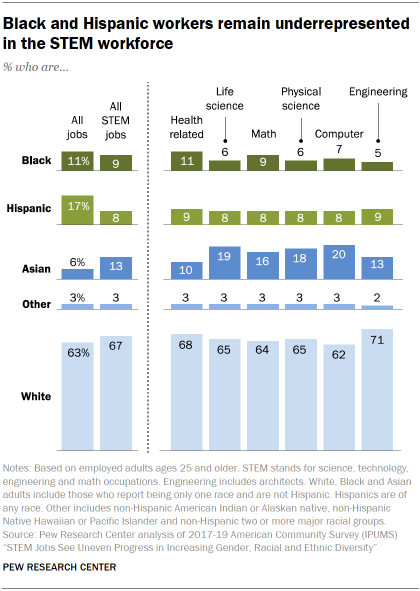Higher education pipeline suggests long path ahead for increasing diversity, especially in fields like computing and engineering
BY RICHARD FRY, BRIAN KENNEDY AND CARY FUNK
Black and Hispanic workers remain underrepresented in the science, technology, engineering and math (STEM) workforce compared with their share of all workers, including in computing jobs, which have seen considerable growth in recent years.

The representation of women varies widely across STEM occupations. Women make up a large majority of all workers in health-related jobs, but remain underrepresented in other job clusters, such as the physical sciences, computing and engineering.
Current trends in STEM degree attainment appear unlikely to substantially narrow these gaps, according to a Pew Research Center analysis of federal employment and education data. Black and Hispanic adults are less likely to earn degrees in STEM than other degree fields, and they continue to make up a lower share of STEM graduates relative to their share of the adult population. And while women now earn a majority of all undergraduate and advanced degrees, they remain a small share of degree earners in fields like engineering and computer science – areas where they are significantly underrepresented in the work force.
What’s a STEM job?
This analysis of the STEM workforce relies on a broad-based definition of those working in science, technology, engineering and math (STEM). STEM jobs are defined solely based on occupation and include any of 74 standard occupations in life sciences, physical and Earth sciences, engineering and architecture, computer and math occupations as well as health-related occupations including healthcare providers and technicians. See the Appendix for specific occupations in each job cluster.
What’s a STEM degree field?
This analysis of STEM degree recipients relies on a broad-based definition of STEM degrees including degrees in life sciences, agriculture and environmental sciences; physical and earth sciences; engineering and architecture; computer and information sciences; math and statistics; and health-related fields. In 2018, 424 bachelor’s, 427 master’s, 336 research doctorate and 44 professional doctorate programs were classified as STEM using the six-digit Classification of Instructional Programs scheme from the National Center for Education Statistics.
While there is often considerable overlap across definitions, there is no commonly agreed definition of the STEM workforce or STEM education fields. Thus, caution is warranted in direct comparisons with other studies.
These findings come amid longstanding efforts to increase diversity in STEM and as the growth in STEM jobs is expected to outpace that of non-STEM jobs in the coming years. STEM occupations continue to rank higher on the pay scale, with the typical STEM worker earning more than those in other occupations.
The gap in STEM workforce representation is especially large for Hispanic adults. Hispanic workers make up 17% of total employment across all occupations, but just 8% of all STEM workers. Their share of all STEM workers is up 1% since 2016, in line with their growth in the overall workforce.
Black workers comprise 11% of all employed adults, compared with 9% of those in STEM occupations. Their share is lower in some STEM job clusters, including just 5% in engineering and architecture jobs. There has been no change in the share of Black workers in STEM jobs since 2016.
The long-term outlook for diversity in the STEM workforce is closely tied to representation in the STEM educational system, particularly across the nation’s colleges and universities. STEM workers are about twice as likely as other workers to have earned a bachelor’s degree or more education (67% vs. 34%) and roughly three-quarters of these workers hold a degree in a STEM field.1
